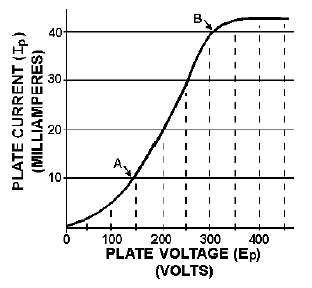1-15
Figure 1-13.—Ep - Ip characteristic curve.
The Ep - Ip curve in figure 1-13, although just an example, is typical of real plate characteristic
curves. You may learn certain characteristics that apply to both diodes and other tubes by studying it.
First, look at the part of the curve to the left of point A. Because it is not a straight line, it is referred
to as NONLINEAR. Note that a change of 150 volts (0-150) caused a change of 10 mA of plate current
(0-10). In comparison with the straight-line part of the curve, between points A and B, this is a relatively
small change in current. The smaller the change in current, the flatter the curve.
In explaining this NONLINEAR portion of the curve, let’s go back just a bit to electron emission.
The electrons emitted by a cathode form a cloud around the cathode. This cloud is called the SPACE
CHARGE. The closer the space charge is to the cathode, the more densely packed it is with electrons. In
our example, the lower plate voltages (0-150 volts) over this part of the curve exert a pull on only the
outer fringe of the space charge where there are few electrons. This results in relatively few electrons
flowing to the plate.
Now look at the center portion of the curve between A and B. This is known as the LINEAR portion
because it is nearly a STRAIGHT LINE. Over this portion, a change of 50 volts Ep causes a change of
10 mA Ip.
The reason for the increased change in plate current for a given change of plate voltage also has to do
with the space charge. With a higher plate voltage (over 150 volts), the attraction from the plate begins to
influence the DENSER part of the space charge that has greater numbers of electrons. Therefore, a higher
current flows for a given voltage than in the nonlinear part. The curve becomes steeper. In our example,
this linearity continues to about 300 volts, point B.
Lastly, let’s look at the top portion of the curve. The plate current plotted here is produced by the
higher plate voltages. However, the amount of current change for a given voltage change is greatly
reduced. The reason for this again involves the space charge. At about 300 volts, almost all of the
electrons in the space charge are flowing to the plate. A higher voltage cannot attract more electrons
because the cathode cannot produce any more. The point where all (or almost all) available electrons are
being drawn to the plate is called PLATE SATURATION or just SATURATION. This is one of the
limiting factors of every tube.

